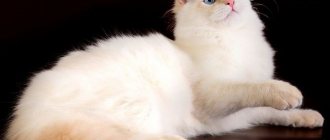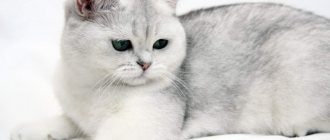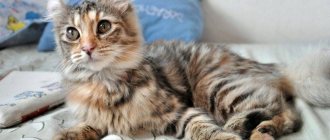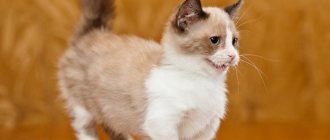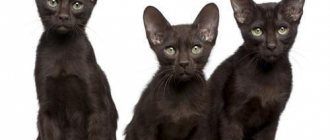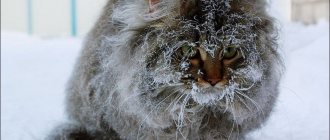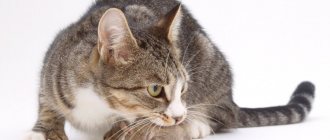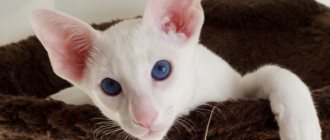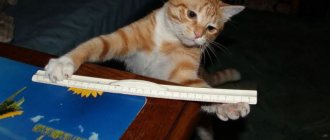Peculiarities
The Lykoi body is completely naked or has multiple bald patches. They are somewhat similar to the Canadian Sphynx, although the genetic background of the two breeds is different. Lykoi's coat is uneven, tuft-shaped and resembles opossum fur. Initially, it may seem that the cat has shingles. Due to the lack of hair on its face, it looks like a werewolf.
The animal has folded skin, especially sensitive to ultraviolet radiation. After several hours in the sun, scattered pigmentation appears, and daily such pastime leads to a continuous black tan. A similar situation occurs when a pet is lying on a heating radiator. Once the animal is protected from heat and sun exposure, the dermis will return its pink tint within 2 weeks. They also sweat in the heat.
Werecat
Likoi is unusual not only in appearance, but also in character. An affectionate and docile cat can instantly become aggressive. This is often associated with the appearance of a stranger in the house, and the werewolf cat turns into the protector of the owner and his family. For her, this is a primary task, like a watchdog. Likoi is so fearless that he is ready to fight even with a large dog.
Despite the occasional wildness, they are friendly and kind in nature to their owner and members of his family. They quickly become attached to them and remain devoted for life. When alone you will always find something to do, which is good for busy people.
It is worth noting the high intellectual capabilities of the breed, which is given by nature. This is manifested in the intelligence and resourcefulness that they show during games.
Description of the Likoi breed
These pets are like wolf cubs among cats. They look strange and unusual. And it’s not just the peculiar coat of wool. The physique is also different from ordinary cats.
Lykoi are thin and dry. The body is slightly elongated, the muscles are strong, but not pronounced.
Lykoy breed standard
The Likoy breed standard has been written and approved, but is still under active development.
The tail of werewolves is somewhat shorter than the elongated body. There is an imperceptible narrowing towards the tip. The paws are thin, but strong, of medium length. The bottom of the paws are bare, devoid of fur. The paw pads are small and oval.
The head has a wedge shape - standard for most cats. The corners are somewhat smoothed, and the forehead is lengthened. The head is smaller than usual. The muzzle is narrow, the whisker pads are rounded and pronounced. The nose is elongated and looks down.
The werewolf's muzzle is bald and not covered with hair. If a descendant of a Lykoi is born with a pubescent muzzle, it is discarded from the breed.
The catwolf's ears are large and wide, pointed at the ends. On the head, the ears are spaced widely. The eyes are large and slightly rounded, shaped like a walnut. Located at a slight angle to the nose. Lykoi owners note that at first, the wide-open and piercing gaze of werewolves is mesmerizing. Eye color is most often yellow. Sometimes there are lykoi with green, blue and light blue eyes.
Lykoia color
Werewolves have special fur. The coat is soft, but uneven and loose. The furs are of different lengths: in some places they are very short, and in others they are of medium length. There is practically no undercoat.
The breed standard allows only one color for catwolves - roan. It is typical, as a rule, only for representatives of the Lykoi breed. Before werewolves appeared, only horses were roan. Roan is a black color with noticeable gray hair. The hairs on the skin are white or light gray, and at the end they are rich black.
It rarely happens that Lycois of a different color are born. Since the breed is completely new, such specimens are not subject to disqualification. However, these animals cannot participate in international exhibitions. As an experiment, blue-colored Lykoi were bred. But such animals were not successful.
Character of the Likoi breed
Lykoi are werewolves not only in appearance. A sweet and affectionate domestic cat can turn into an angry wolf cub in the blink of an eye. This always happens when the Likoi feels threatened or in danger. When a catwolf becomes attached to “his person,” he begins to protect not only his own space, but also his owner. For example, a cat regards the appearance of a stranger on the territory of a house as a threat to the owner.
They say that with proper upbringing, a Lykoi can grow into a real home guard. A werewolf is no worse than a guard dog, ready to defend its territory against strangers.
Werewolves are fearless and wild. They will not be afraid even of a large dog. Interestingly, there are no wild animals, predators or dogs in the werewolf family. The ancestors of werewolves are ordinary American shorthair cats. Perhaps the mythical appearance left its mark on his character.
The werewolf becomes attached to the owner almost like a dog; he is a devoted and reliable comrade. However, Lykoi tolerates loneliness calmly. The owners say that even when forced to leave for long periods of time, the animals cope well on their own. The main thing is that before a trip or a long business trip you need to take care of the cat’s nutrition. The ideal option: ask your neighbors or friends to come by at least once every few days to feed the werewolf.
Lykoi have high intelligence. They are smart, resourceful and quick-witted. It is easy to accustom them to the tray and teach some basic procedures, since catwolves understand everything perfectly. In addition, Lykoi are considered excellent hunters. Experts recommend letting werewolves roam. They benefit from physical activity in the fresh air and the opportunity to practice hunting. However, at first it is better to take your pet for a walk on a leash. Bold and fearless werewolves can escape.
Catwolves do not take good care of children, especially the smallest ones. If you have a child, postpone purchasing Lykoi until your baby is older. Lykoi are still poorly studied, but experts have already noticed that these animals are not distinguished by good manners. They tend to show aggression.
Lykoi health
To an inexperienced person, it may seem that the animal is sick and needs treatment. However, bald spots on the skin and a skinny physique are not signs of illness. Today, werewolves are considered strong and healthy creatures.
Lykoi are susceptible to all the standard feline diseases. But hereditary diseases have not yet been recorded. Since the breed is still completely new and is almost at the very beginning of its active development, it is not yet possible to say with confidence about the strong good genetics of the Lykoi. Lykoi has not yet been thoroughly studied. There is a risk that some genetic abnormalities and problems will subsequently appear. But today, wolf cats are considered strong, resilient and healthy animals.
The average lifespan of cat werewolves is 15 years. Among the Lykoi there are often long-livers celebrating their 18th birthday!
Historical path of the breed
The Lykoi breed accidentally appeared in 2010 as a result of an experiment by a lady from Virginia (USA), who crossed a female American shorthair cat with a Sphynx. They hoped that the specimen would be strong in build and bald. The result was amazing - kittens were born with a coat of uneven length, completely absent in some places. Despite their originality, the offspring turned out to be healthy.
Studies were carried out that confirmed the viability of the mutants. In the process, it became clear that there was no genetic connection with sphinxes and other similar felines. The animals inherited the entire set of chromosomes from the short-haired parent.
Feeling threatened, the Likoi are ready to engage in battle with the enemy.
Without thinking twice, the breeders decided to breed such exotic species.
And 2 years later they were officially registered as a separate breed of cats. They decided to keep the name of the horror movie character that the owner gave them.
Cat breeds (prices)
Peterbald (Petersburg Sphynx)
Price: 1200 – 5000 dollars
Peterbalds are the result of an experimental mating between an Oriental Shorthair cat and a Don Sphynx cat. This is an inquisitive, intelligent, energetic breed with an elegant slenderness and strong build.
Persian cat
Price: 500 – 5500 dollars
A popular breed of long-haired cats with a calm, affectionate character.
Bengal cat
Price: 1000 – 25,000 dollars
This very beautiful cat breed is a mixture of an Asian Bengal cat and a domestic cat. Combines the personality of a dog and a playful nature.
Savannah
Price: $1,500 – $50,000
The Savannah is a cross between a domestic cat and a serval cat. They are often compared to dogs for their loyalty. In addition, they are exceptionally smart.
Breed standard according to the TICA federation
Since the breed was not bred artificially, but was formed as a result of a genetic mutation, many phenological organizations did not recognize it. TICA is one of those federations that recognized Lykoev. According to their requirements, the breed must meet certain standards. It was developed in 2012.
Head
Small in size, wedge-shaped, with rounded cheekbones. The frontal area is slightly convex, elongated, not particularly wide.
Muzzle
Likoi is a graceful cat with a penetrating gaze.
Bald in the central part, small in size. The whisker pads are fleshy and without hair. The wide nose is depressed at the border between the bridge of the nose and the forehead. On the same line is a rounded, well-developed chin.
Ears
Wide, far apart ears point at the tips. They are erect. The outside is covered with fine pile, the inside is bare.
Eyes
Huge almond-shaped eyes directed upward along an oblique line. The look is open and welcoming. The area around the eye sockets is devoid of hair, and the whiskers on top are often absent. The iris is colored golden, blue-gray or greenish.
Nose
Lint-free, smooth and leathery to the touch. Located on the same vertical line with the forehead and chin, slightly directed downward. The pillow with nostrils is slightly expanded and round in shape.
Body
The physique is of medium density, muscular and flexible with smooth outlines. The general impression is that the animal is slender and harmonious.
Limbs
There is scanty hair on the paws, as on all limbs. The latter are not particularly long, slender. Paws are small, oval, with elongated toes. The pads are painted dark.
Tail
Shorter than the body, tapering towards the end. Covered with uneven shedding of long hair.
Coat
The coat is not particularly thick, silky, of different lengths (the guard hairs are longer). There is no undercoat at all or very short. The thickness of the fur depends on the season. This is the only breed that has hair that feels similar to human hair.
Color
Acceptable color options depending on class:
- show – roan (a mixture of black and white hair in a 1:1 ratio, dark inclusion can be from 30 to 70%);
- brid – resinous or smoky;
- outcrossing – pure black.
Likoi's kittens are born with a resinous color. The gray hair inherent in the breed appears gradually as it matures.
Description of appearance
The defining features of the Lykoi are the complete absence of undercoat and the presence of white guard hair, called “ron”. Only horses and dogs have this hair structure, which is why Lykoeis are also classified as cat-dogs. Kittens are usually born with solid black fur, which only after the first molt begins to be “diluted” by growing white hair. From birth, babies have no hair on the top of the ears (outside), around the eyes, in the chin area and near the nose. The nose and ears are leathery to the touch.
Dimensions and weight
They are still in development, although the preliminary requirements for the exterior of the Lykoi are already known. An adult cat weighs from 3.5 to 4.5 kg, a cat is slightly smaller - from 2 to 3.5 kg. The body structure of werecats is similar to the Canadian Sphynx.
Fantastic handsome werewolf Lykoy
Anatomical features
Despite the fact that the werewolf cat is a young breed, it already has clear standards of appearance.
Appearance description:
| Head | It has the shape of a modified wedge with rounded lines from the nose to the cheeks. The forehead is slightly rounded, slightly longer than wide. |
| Muzzle | Middle length. Fleshy, softly rounded hairless whisker pads, pinch. The muzzle ends in a well-developed chin, aligned vertically with the nose, and having a rounded shape. |
| Nose | Smooth, leathery to the touch, slightly pointed downwards and rounded at the end. There is a mask characterized by the absence of hair. The profile forms a concave curve from the forehead to the bridge of the nose. |
| Ears | Large, wide at the base and pointed at the tips. Located high on the head, erect. The outer surface is covered with sparse hair. There is no internal hair. |
| Eyes | Large, wide, directed obliquely upward. The expression of the eyes is open. There is no fur around the eyes. Vibrissae above the eyes are most often absent. Golden eye color is preferred. |
| Neck | Middle length. Neither thin nor overly muscular. |
| Body | Medium type with pronounced muscles. The lines are smooth, the overall impression is that of a flexible, slender animal of harmonious structure. |
| Limbs | Sparsely covered with hair, paws may be hairless. Middle length. Paws are medium in size and oval in shape. The fingers are long. Pads dark colored. |
| Tail | The body is shorter, tapering towards the tip, and covered with sparse long hair. |
| Wool | The coat is not dense, soft to the touch, from short to medium length. Undercoat is minimal or absent. The guard hair covering the body is long. The amount of hair varies depending on the season. The appearance of the fur resembles that of an opossum and/or the feel of human hair. |
Color
The standard color is roan, or as it is also called “salt and pepper”. Black wool should be diluted with gray 50/50 or 70/30.
Individuals with a different color are allowed for breeding and are considered purebred, but do not participate in exhibitions.
Defects:
- Absence of a bald mask on the face;
- The absence of characteristic bald patches on the animal’s body in the paw area;
- Color discrepancy (with this defect, animals are only allowed for breeding).
- Violation of the structure of the tail or its low mobility.
- The presence of congenital mutations of the fingers.
- Blindness or strabismus.
Bright representatives of the Lykoi werewolf breed
Character traits
One of the main character traits of cats of this breed is playfulness, which they maintain throughout their lives. You can rarely see them lying on the sofa. Cats spend a lot of time having fun and active games. In general, at their core, Lykoi are real hunters. They love to chase the ball, catch insects, and chase prey. Their behavior at home is very reminiscent of puppy play. But owners must take into account that the hunting instincts of these animals sometimes cross the line of games.
These are very smart, gentle, loyal animals. They treat all family members equally well, but show greater affection to the owner.
Catwolves perfectly remember the rules of life in the apartment established by the owner, and behavior with him. Practice shows that mutual love and trust between such a cat and the owner allows one to find the key to mutual understanding. As for the purpose of Lykoi cats, these are cats for apartment living.
Werewolf loves to play and hunt
With other cats and even with dogs, the werewolf cat will immediately find a common language and get along well with them. But these cats are not at all friendly towards small pets, such as hamsters, canaries or aquarium fish and perceive them as potential prey.
Strangers cause fear and strange behavior in cats. In rare cases, a cat is ready to attack a stranger in defense of itself and its owner. Such wild notes of character can appear in a Lykoi cat in relation to other animals. Even large dogs are not an obstacle for them that they are afraid of.
Health
Likoya can hardly be called a cute cat.
Maybe visually Liki seems not quite healthy, due to her strange appearance, but in reality this is not the case. The breed is surprisingly strong and resistant to all kinds of diseases. This fact has been confirmed by repeated genetic and veterinary studies. True, geneticists do not exclude the possibility of some hidden anomalies. So far, nothing has been revealed in this regard.
There is no exact information about the life expectancy of Lykoi, since the breed is new. Based on existing data, demon cats with proper care can easily live up to 15-16 years.
Origin story
Likoi is a cat breed that appeared in 2010. Then, American breeder Patty Thomas, when crossing hairless cats with ordinary cats, had a litter with a strange appearance. Thomas's goal was to breed large-bodied sphinxes. The breeder, seeing the result of her labors, considered the litter sick and unviable. But veterinarians refuted her assumptions, recommending that the kittens be examined more carefully.
After the babies were shown to the Gobble spouses (large Sphynx breeders), it was found out that there was a rare change in the genotype of the kittens, which affected the appearance of the offspring. Subsequently, felinologists again crossed ordinary cats with sphinxes, resulting in another litter of unattractive kittens.
The results of the study showed that little “werewolves” have good health. And the main gene responsible for appearance affects only hair follicles. During seasonal molting, the animal becomes almost bald. Cats have no undercoat and guard hairs are not thick.
This section of DNA is recessive. Therefore, the litter may contain babies different from their relatives.
In further breeding, the first resulting litters were used, crossing them with ordinary outbred cats. The breed received official recognition in 2012 only in America. Breeders chose from two names - opossum cat and werewolf cat (Lykoi). The second name stuck.
In the world community, Lykoi are recognized, but with the note that these are representatives of a new developing breed.
Character and temperament of a werecat
By nature they are good-natured, sociable and obedient creatures. They are as loyal as dogs to their owners, but they are wary of strangers. Sensing a potential threat from the outside, they can attack and even bite. But then, when they realize that the alien is harmless, they can honor him with their friendly attention.
Werecats love to spend time with their family members, but even when left at home alone they find something to do and never get bored. Even when separated from their owner for a long time, they do not become depressed.
The Lykoi have a highly developed hunter's instinct
They get along well with their brothers, including dogs of an easy-going nature. Conflicts between pets cannot be ruled out from time to time. Due to their hunting origin, Lykoi will not tolerate proximity to small representatives: hamsters, mice, birds. They will definitely become prey.
Character and behavior
The frightening appearance of Lykoi masks their strong attachment to their owners. They like to be the center of everyone's attention. And due to their high intelligence, animals easily remember the rules of behavior in the apartment.
They treat strangers with distrust and rarely let them in, but once they find out that the guest does not pose a threat to the hosts, they make contact. At the hint of danger, they rush at the offender no worse than a dog, and the large size of the enemy does not bother them.
Werecats, especially kittens, are hyperactive, so older people and families with small children should refrain from purchasing such a pet. The attitude towards dogs and other cats is neutral, but Lykoi are natural hunters, so in the apartment you will have to cover the aquarium and hide cages with small rodents and birds.
Breeders have noticed that Lykoi sometimes “pray” - they freeze in the gopher pose, with their paws folded on their chest. They spend long minutes in this position, staring into the vast distance.
Video: Lykoi kittens
Rules of care and conditions of detention
They are unpretentious and do not require delicate care or special living conditions. But this does not negate compliance with standard rules for keeping a pet.
Hygiene procedures
Werecats, although unpretentious, love comfort and kind treatment.
Basic hygiene for cats involves the following procedures.
- Trimming claws. They use a special device - a nail clipper. Only the transparent ends are cut so that there is no possibility of damaging the furniture. And for such needs they buy a scratching post.
- At least 2 times a week, brush your teeth with a special paste without foam using a soft brush. To prevent plaque and tartar, periodically give your pet cat treats.
- Ears and eyes are examined regularly. If discharge is detected, remove it with a cotton pad using a decoction of herbs or lotion without alcohol.
Grooming
The coat is easy to care for, given its scarcity. This is due to repeated molting throughout the year. This is really a problem for household members. To prevent tufts of hair from lying around everywhere, you need to systematically comb the animal. Use a brush designed for this purpose, sold in pet stores.
Lykoians tend to sweat. Therefore, bare areas of skin are often wiped with a damp cloth, especially in the hot season.
But bathing is often not recommended due to the risk of catching a cat’s cold.
Tray
Representatives of this breed are extremely clean. They quickly learn to go to the toilet where they are supposed to. While small, a small tray with low sides will be enough. Adults will need a bowl that matches their size. It is preferable to use wood or mineral (granular) filler.
Content Features
Lykoi are perfectly suited for living in an apartment or in a house, they quickly adapt to new conditions, become attached to all family members, and are neat and clean. Contrary to popular belief, they are not hypoallergenic. Like other cats, they shed, the degree of shedding depends on the time of year, the amount of hair on the body and climate. The fur is very soft to the touch, the naked body is warm and velvety, and the nose, as expected, is cold and wet.
Lykoi are very friendly, so they easily get along with other pets, cats, dogs, small rodents and birds, anyone who doesn’t mind their company.
The effects of heat and cold on bare skin are more active than in coated cats. In the cold season, it is advisable for them to select clothes according to the weather, and in the summer to protect them from excess direct sunlight, which can cause burns. Given the high activity of the cat, it is advisable to install a play complex.
Care
Grooming is an important part of keeping a cat; it is not difficult since cats have little hair. For bathing, it is recommended to use a mild cat shampoo with a natural hypoallergenic base. The frequency of washing is individual in each case and depends on the skin type.
Some lykoys are washed once a month, others - once every six months. Periodically comb the cat or remove mature hairs with a damp hand. Ears need to be cleaned regularly. A peculiarity of the breed is the accumulation of brown secretion from the sebaceous glands in the ear and near the claws, which must be carefully cleaned approximately once a week.
Nails should be trimmed regularly. Like Sphynxes, they have a brown secretion around their claws, which is rarely a sign of illness and can be easily removed.
Feeding
There are no special feeding recommendations. Like other cats, the Lykoi needs a balanced, healthy diet. Most breeders prefer wet or dry ready-made food.
Lykoyam diets are suitable for domestic cats of small and medium breeds. You should not pay attention to food below the super-premium class. If you wish, you can provide cats with complete natural nutrition, but this will be difficult, given that they are often picky eaters.
Feeding the werecat
Due to the lack of thick wool protection, they have a high level of thermoregulation. Therefore, they are quite gluttonous. This nuance is taken into account when preparing your pet’s daily diet. However, there is no need to overfeed, which will lead to obesity.
Diet
Premium cat food
When choosing food for a werewolf cat, it is preferable to choose premium, high-quality food. First of all, they look at the expiration date and composition. The feed should not contain soy, wheat, or corn. The most suitable brands: Royal Canin, Acana.
If the owner is inclined towards natural nutrition, then be sure to include in the menu:
- raw lean meat;
- sea fish;
- offal;
- quail eggs;
- porridge;
- boiled vegetables;
- fermented milk products.
It is strictly forbidden to give sausages, smoked meats, pickles, mushrooms, potatoes, sweets and baked goods. You cannot train your pet to accept food from the owner's table.
How often should you feed?
The intensity of feeding depends on the age of the animal. Up to 4 months, the number of meals reaches 6 times, then reduce to 5 and adhere to this regimen for a month. Over the next 4 months, they switch to four meals a day, and by the year they try to switch the pet to three meals a day. Starting from a year, two feedings a day will be enough.
Vitamin and mineral supplements
To prevent the development of vitamin deficiency, vitamin and mineral complexes are introduced into the diet. This is done twice a year. A veterinarian will help you make your choice.
Vaccination and treatment against parasites
They can be affected by various infections, like other felines. Timely vaccination will help avoid this. For the first time, vaccinations against rhinotracheitis and calcivirosis are given upon reaching 8 weeks. Repeat a similar procedure after 27-28 days. In the future, the demon cat is vaccinated once a year.
To protect representatives of this breed from diseases carried by fleas and worms, regular anti-parasitic treatment is required. They deworm in 2 passes, with an interval of 10 days. Special drops and shampoos are used as flea prevention.
Horoscope compatibility
In terms of compatibility, this cat breed is ideal for people of the zodiac signs Sagittarius and Aquarius. This is due to the non-standard appearance and personality traits.
Since Sagittarians prefer everything unusual, they will definitely be attracted to this breed. The character of the animal is characterized by traits that are also characteristic of the zodiac - external intransigence is combined with internal complaisance and gentleness. Likoy is restless, playful, intellectually developed, and will become a loyal friend and protector to his owner.
Aquarians love to attract the attention of others with their eccentricity, they easily make new acquaintances and are pleasant to talk to. They are a complete reflection of this sign. Their devotion is akin to that of a dog. Aquarius will not be bored in such a company, and most importantly, comfortable.
How to choose a kitten
Likoi kittens
When choosing a Likoi kitten, it is recommended to pay attention to a number of points. Required availability:
- black fur;
- on the face of a bald mask;
- bald patches on the pads of the paws.
It is advisable to take with you a photo of the real Lykoi. The demand for the breed is growing tirelessly; unscrupulous breeders take advantage of this and often deceive buyers.
Buying a kitten is not easy due to the rarity of the breed. There are about 7 nurseries around the world (most are in the USA) where you can buy true Lykoi. Even there, the kitten will not be sold immediately; you will have to sign up and wait a long time for your turn.
Kitten care
After birth, kittens live in a nursery or with the owner of the mother cat for up to 12 weeks. Only then does the distribution begin. By this time, babies are accustomed to eating solid food, relieving themselves in a tray, and are routinely vaccinated.
Likoev kittens quickly get used to a new place
So that the kids do not experience discomfort from changing their place of residence, the new owners prepare everything in advance. You need a comfortable bed and a few small toys. Be sure to block access to electrical wires, indoor plants, cleaning products and anything that could injure a curious new resident. In just a few days, the kittens adapt.
How much does a kitten cost approximately?
Since the breed is rare in Russia, it is difficult to say the exact price for kittens. It is known that the cost starts from 150 thousand rubles. Defective copies can be purchased from 90 thousand rubles. Additionally, the costs of delivery from America and preparation of accompanying documentation are added.
Buy Lykoya
Lykoi are not yet available for open sale. If you believe the statistics, then by 2021 only 54 representatives of the new breed were registered all over the world. Of these 54 cats, only 32 animals were colored in the characteristic roan color of the Lykoi. 22 cats received a blue color as an experiment.
By the way, the blue and gray-blue color of the coat did not suit the face; such animals are not in demand. It was decided to leave only the main color in the standard, and consider the rest as signs of disqualification.
There are rumors that some people still manage to buy kittens with mangy skins, but such specimens cost exorbitant amounts of money. Allegedly, roan kittens cost at least 2-3 thousand dollars (in rubles this is at least 100 thousand rubles). Blue animals are cheaper - one and a half thousand dollars per animal (from 75-80 thousand rubles and more).
In Russia and the CIS, only private breeders are engaged in breeding Lykoi, who, as a rule, specialize in other breeds. Werewolves are available in nurseries in single copies; they are kept not for sale, but for the further development of the breed.
The good health of the animals and the persistence of the mutated gene are encouraging. Experts expect a rapid increase in the werewolf population. Perhaps in 10-20 years, mystical dark animals will be available to everyone, even in our country.
Interesting facts about werecats
Some interesting facts about cats with demonic appearance:
- before the appearance of the Lykoi, roan coat color could be seen exclusively in horses;
- representatives of this population of cats sometimes become completely bald during molting, but soon grow back with fur;
- They are characterized by one quirk - periodically they freeze in a praying pose (like gophers), pressing their paws to their chest. They can remain in this state for a long time. If you extend your hand to them at this time, they will extend their paw in response.
Lykoi are extraordinary not only in appearance, but also in their behavior. This causes conflicting emotions among others. By appreciating their unique beauty, you can acquire a faithful and kind friend.
General characteristics and description
Despite the fact that the breed was bred quite recently, clear standards for the appearance of the Lyka cat and its main characteristics have already been defined.
Breed standard
Pixie bob cat is an interesting breed
The following requirements are imposed on representatives of the werecat breed:
- roan coat color (black interspersed with white hairs);
- wedge-shaped muzzle, in the center of which there is no fur;
- bald nose with a slight hump;
- expressive huge eyes. Their color can be different: bright green, yellow, gray, blue, but gold is considered the best;
- large erect ears, the upper part of which is covered with sparse hair;
- paws of medium length with long toes and a small amount of hair;
- flexible, strong, elongated body;
- sparse black fur all over the body. There is almost no undercoat. There is long guard hair (rare for cats);
- cats weigh very little, no more than 3.5 kg. Cats are larger - up to 4.5 kg.
Color
The rare fur of Lyka cats is black with small patches of gray hairs. They have a light base and a black tip. It happens that kittens are born of different colors. They are not excluded from the breed, but they are no longer suitable for exhibitions.
For your information! At birth, the kittens' body is covered with only black fur, but with age the color changes and becomes roan.
The Lykoi kitten changes color over time

